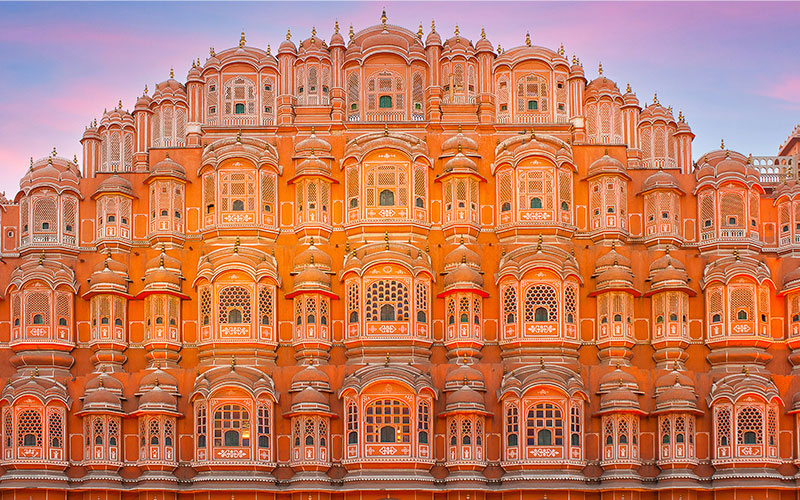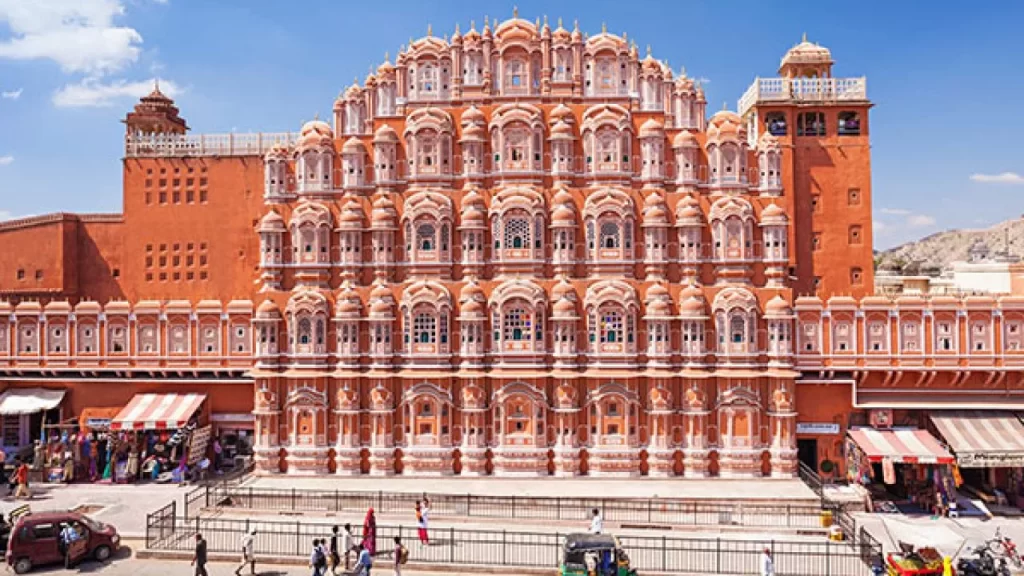Hawa Mahal
There are many adjectives to describe Hawa Mahal or the Palace of Wind in Jaipur and to choose one word is really difficult because Hawa Mahal leaves you speechless with its sheer magnificence and beauty. Built in 1799 by the poet-king Maharaja Sawai Pratap Singh, Hawa Mahal is one of the most popular tourist destinations of Rajasthan. A symbol of the splendid Rajput style architecture, Hawa Mahal is five storied and the main feature is the 953 small windows, or jharokhas that are intricately designed. It was primarily built for royal ladies so that they could watch the city and different proceedings from behind these windows. It was called Hawa Mahal as these windows allowed great air circulation which kept the chambers cool all the time.
- It was an architect named Lal Chand Ustad who designed Hawa Mahal. Built in red and pink sand stone, the Hawa Mahal is not actually a palace but more of a gallery, used by royal women of those times.
- The architectural style is a combination of Hindu-Rajput-Islamic styles.
Hawa Mahal History
Hawa Mahal was worked by Kachhwaha Rajput ruler Maharaja Sawai Pratap Singh in the year 1799. At the point when the maharaja saw the design of Khetri Mahal in Jhunjhunu, Rajasthan, he was dazzled to such an extent that he chose to fabricate a royal residence demonstrated on it. Hawa Mahal, additionally called the Palace of Breeze, was the aftereffect of that motivation.
This five-celebrated structure was planned by Lal Chand Ustad as an expansion of the City Palace. Beginning from the City Palace’s edge, Hawa Mahal stretches out to the ladies’ chambers also known as zenana. During those days, the Purdah framework was completely followed and Royal Rajpur ladies weren’t permitted to show their face to outsiders or even show up in broad daylight. The royal residence contains 953 windows which empowered them to get a brief look at the everyday activities and celebrations occurring in the city underneath without showing up openly.


Hawa Mahal Architecture
Hawa Mahal, one of the most outstanding spots to visit in Jaipur, highlights an unbelievable combination of Islamic, Mughal, and Rajput design styles. Its domed coverings, botanical examples, lotus themes, and fluted points of support, all mirror the rich Rajput style. Supplementing these components is the filigree work in stone and luxurious curves, the two of which draw impact from the Islamic style of engineering.
Planned in red and pink sandstone, this one-of-its-sort castle brags of a pyramidal shape. It has five stories and ascends to a level of 50 feet. The 953 windows highlighted on the forward portion of the castle loan it a honeycombed hive look. Because of the uncommon latticework on these windows, the castle encounters a cooling impact as the breeze blows in through them. Gently planned hanging moldings are one more alluring part of Hawa Mahal’s design.
Facts about Hawa Mahal
- As of late, the travel industry division has enlightened the outsides of Hawa Palace trying to advance night the travel industry in the city.
- Unlike other palaces, there’s no entryway in the front of the palace. You need to enter through a door that exists at the side of the building.
- It was the favorite resort of Maharaja Jai Singh who loved Hawa Mahal for its cooling effect as well as decorated interiors.
- Every one of the five stories of the Hawa Mahal has a sanctuary in it. Sharad Mandir exists on the primary floor while the Ratan Mandir with bright glasswork is on the subsequent floor. Vichitra Mandir, Prakash Mandir, and Hawa Mandir decorate the main three stories.
- There are no stairs to reach the upper floors of the palace. Ramps were built, instead, as it was easy to carry palanquins of Rajput royal ladies on ramps.
